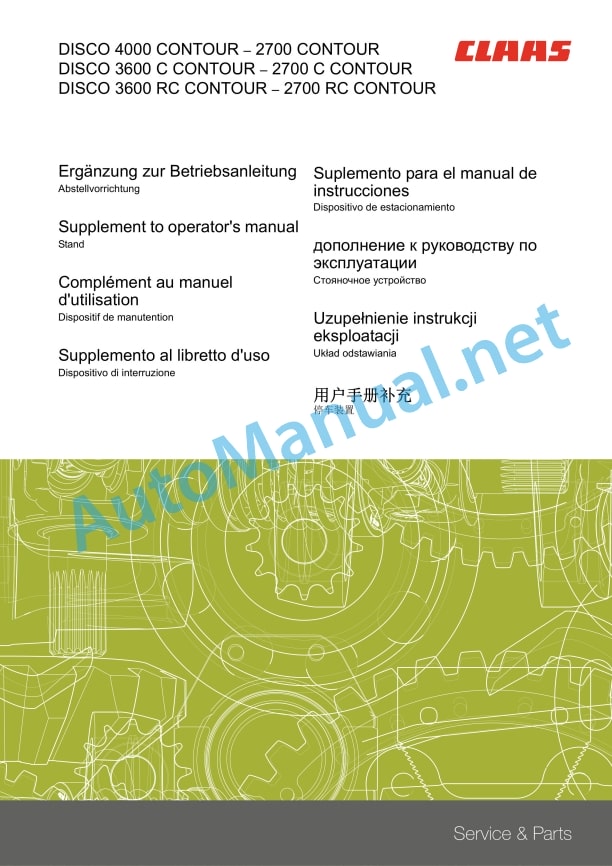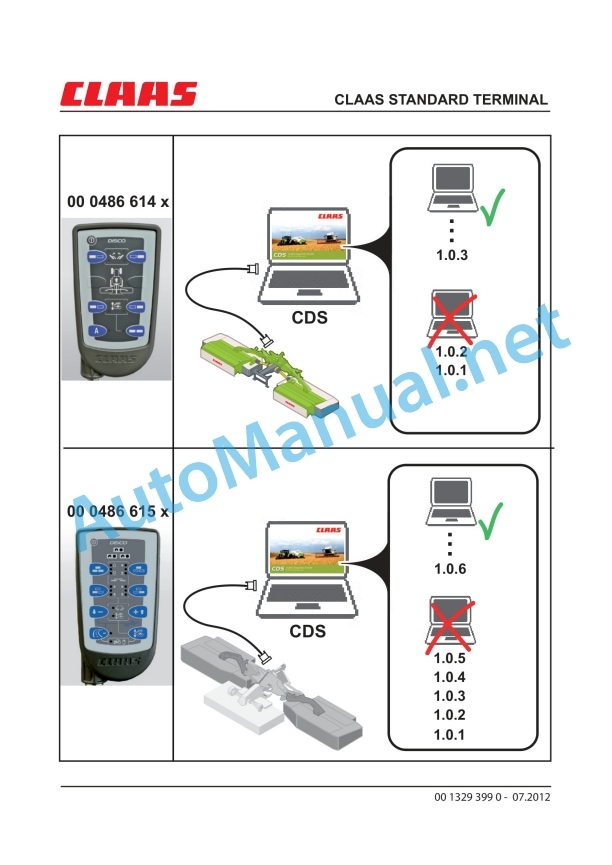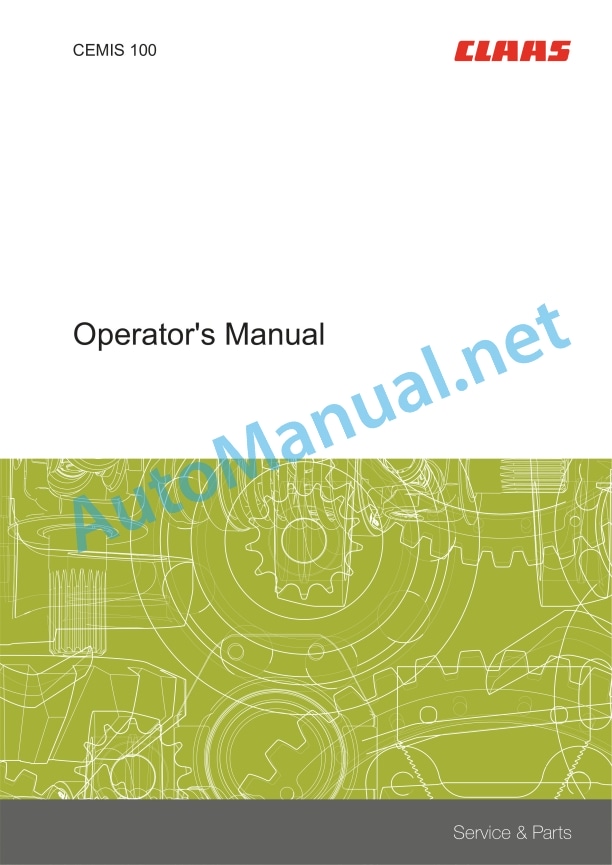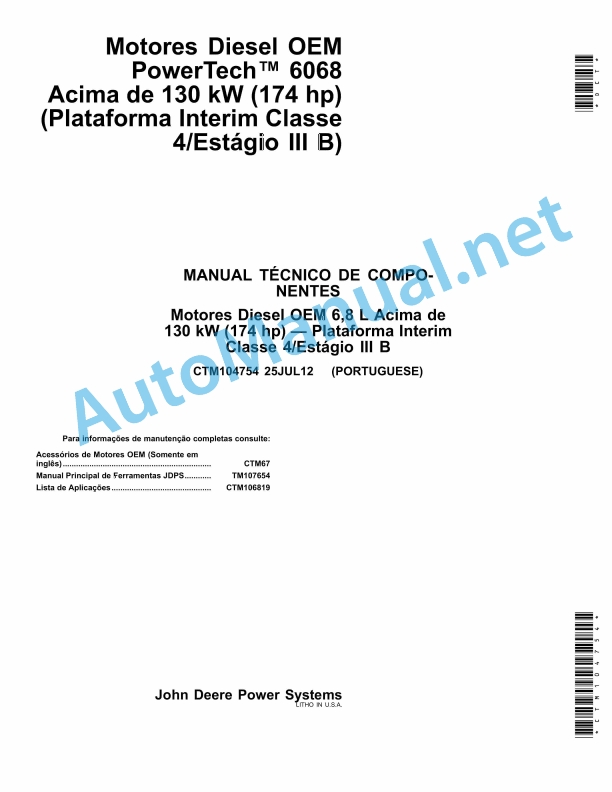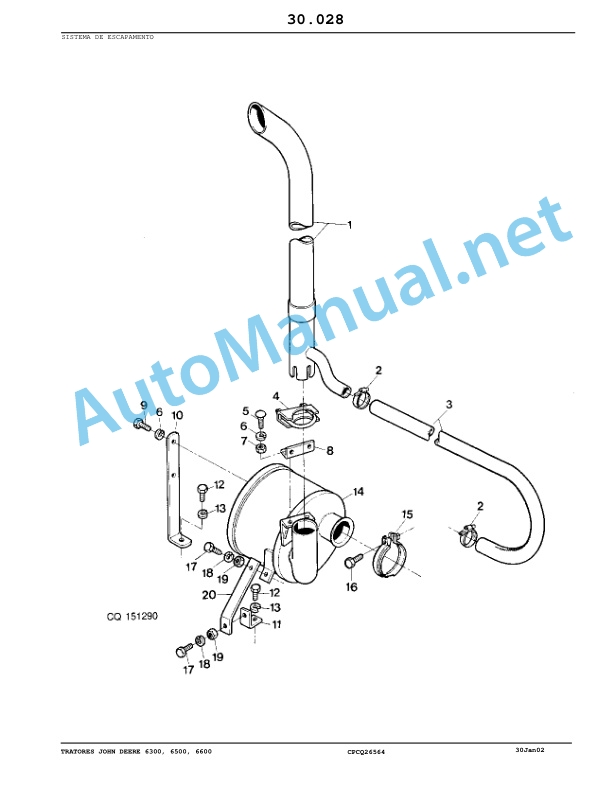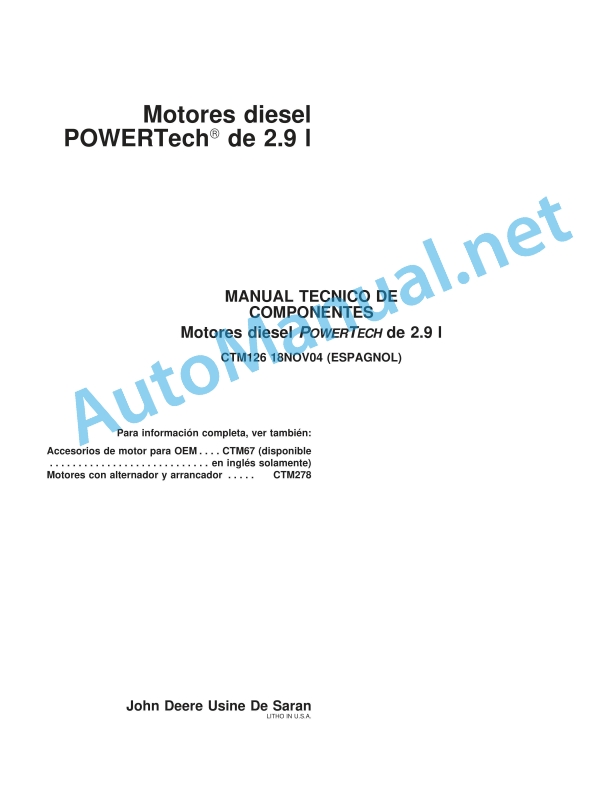Claas Disco 3100 C (997) Mower Operator Manual EN
$50.00
- Model: Disco 3100 C (997) Mower
- Type Of Manual: Operator Manual
- Language: EN
- Format: PDF(s)
- Size: 44.2 MB
File List:
00 0294 730 5.pdf
00 0298 546 0.pdf
00 1329 399 0.pdf
00 2348 408 0.pdf
00 2348 427 0.pdf
00 0294 730 5.pdf:
DISCO 3500 C Contour / RC Contour
DISCO 3100 C Contour / RC Contour
DISCO 2700 C Contour / RC Contour
Table of contents
1 To this operator’s manual
1.1 Notes on the manual
1.1.1 General instructions
1.1.2 Using the manual
Directions
1.1.3 Validity of manual
1.1.4 Symbols and notes
1.1.5 Technical specifications
2 Safety
2.1 Safety rules
2.1.1 Particularly important
2.1.2 Qualification of drivers and maintenance personnel
2.1.3 Intended use
2.1.4 Reasonably foreseeable misuse
2.1.5 Safety and accident prevention regulations
2.1.6 First aid measures
2.1.7 Danger of injury from hydraulic liquid
2.2 Safety decals on the machine
2.2.1 Safety decals
2.2.2 Position of hazard warning signs
3 Machine description
3.1 Overview and method of operation
3.1.1 Overview of DISCO 3500 C / 3500 RC / 3100 C / 3100 RC / 2700 C / 2700 RC
3.1.2 Function of DISCO 3500 C / 3100 C / 2700 C
3.1.3 Functions of DISCO 3500 RC / 3100 RC / 2700 RC
3.2 Optional machine equipment
3.2.1 High-cut skids
3.2.2 Bolted wear skids
3.2.3 Crop spreader
3.2.4 Slip-on yoke for 8-piece universal drive shaft
3.2.5 Slip-on yoke for 21-piece universal drive shaft
3.2.6 Hydraulic system connectors, 3-fold
3.2.7 Collision protection and safety frame
3.2.8 Legal equipment
3.2.9 Legal equipment for France
3.2.10 Legal equipment for Switzerland
3.3 Identification plate and vehicle identification number
3.3.1 Spare parts and technical questions
3.3.2 Position of identification plate
3.3.3 Position of identification no.
3.3.4 Explanation of machine identification plate
4 Operating and control elements
4.1 Fitting frame
4.1.1 Shut-off tap
4.1.2 Pressure gauge
4.1.3 Stand
4.2 Mower unit
4.2.1 Pull rope
4.2.2 Adjusting aid
4.3 Conditioner
4.3.1 Lever
4.3.2 Star handle
5 Technical specifications
5.1 DISCO 3500 C Contour – Type 998
5.1.1 Dimensions
5.1.2 Weights
5.1.3 Requirements for the tractor
5.1.4 Version
5.1.5 Sound pressure level
5.1.6 Lubricants
5.2 DISCO 3500 RC Contour – type 998
5.2.1 Dimensions
5.2.2 Weights
5.2.3 Requirements on the tractor
5.2.4 Version
5.2.5 Sound pressure level
5.2.6 Lubricants
5.3 DISCO 3100 C Contour – Type 997
5.3.1 Dimensions
5.3.2 Weights
5.3.3 Requirements for the tractor
5.3.4 Version
5.3.5 Sound pressure level
5.3.6 Lubricants
5.4 DISCO 3100 RC Contour – Type 997
5.4.1 Dimensions
5.4.2 Weights
5.4.3 Requirements for the tractor
5.4.4 Version
5.4.5 Sound pressure level
5.4.6 Lubricants
5.5 DISCO 2700 C Contour – Type 996
5.5.1 Dimensions
5.5.2 Weights
5.5.3 Requirements for the tractor
5.5.4 Version
5.5.5 Sound pressure level
5.5.6 Lubricants
5.6 DISCO 2700 RC Contour – Type 996
5.6.1 Dimensions
5.6.2 Weights
5.6.3 Requirements for the tractor
5.6.4 Version
5.6.5 Sound pressure level
5.6.6 Lubricants
6 Machine preparation
6.1 Tractor preparation
6.1.1 Axle loads, minimum ballast, total weight
6.1.2 Calculating the minimum front ballast
6.1.3 Calculating the minimum rear ballast
6.1.4 Calculating the actual front axle load
6.1.5 Calculating the actual total weight
6.1.6 Calculating the actual rear axle load
6.1.7 Calculation table
6.2 Shutting down and securing the machine
6.2.1 Switching off and securing the machine
6.2.2 Securing the raised machine
6.3 Adapting the machine
6.3.1 Adapting the lower link pin
6.3.2 Adapting the lower link category
6.3.3 Adapting the upper link category
6.3.4 Universal drive shaft – Checking the length
6.3.5 Universal drive shaft – Adapting the length
6.3.6 Fitting the universal drive shaft to the machine
6.4 Hitching the machine
6.4.1 Hitching up the attachable frame
6.4.2 Installing the universal drive shaft
6.4.3 Connecting the hydraulic hoses
6.4.4 Connecting the electrics
6.4.5 Raising the jack stand
6.4.6 Laying the pull ropes
6.5 Unhitching the machine
6.5.1 Preparing removal
6.5.2 Lowering the jack stand
6.5.3 Removing the pull ropes
6.5.4 Disconnecting the hydraulic hoses
6.5.5 Disconnecting the electric system
6.5.6 Removing the universal drive shaft
6.5.7 Unhitching the attachable frame
6.6 Loading the machine
6.6.1 Loading / unloading the machine
7 Operation
7.1 General safety precautions
7.1.1 Prior to operation
7.2 Driving on the road
7.2.1 Road travel
7.2.2 Marking the machine for road travel
7.3 Fieldwork settings
7.3.1 Adjusting the attachable frame
7.3.2 Adjusting the mower unit load relief
7.3.3 Adjusting the cutting height
7.3.4 Adjusting the tine conditioner
7.3.5 Adjusting the roller conditioner
7.3.6 Adjusting the swath width
7.3.7 Adjusting the crop spreader*
7.3.8 Mowing without conditioner effect
7.3.9 Engaging the bump safeguard
7.3.10 Retensioning the bump safeguard
7.4 Fieldwork
7.4.1 Fieldwork
7.4.2 Swinging to transport position
7.4.3 Folding to working position
7.4.4 Machine use
Optimum PTO speed
7.4.5 Mowing methods
7.4.6 Turning area position
7.4.7 Instructions for mowing
7.4.8 Difficult conditions of use
7.4.9 Recommendation for environmental protection
8 Faults and remedies
8.1 Causes and remedies
8.1.1 General warnings
8.1.2 General trouble and remedy
9 Maintenance
9.1 Maintenance Information
9.1.1 General warnings
9.1.2 Electrical system
9.1.3 Protective guards
9.1.4 Spare parts
9.1.5 Unbalance
9.1.6 Compressed air and water
9.1.7 Burn prevention
9.1.8 Oils
9.1.9 Fire prevention and explosion prevention
9.1.10 Lines, tubes and hoses
9.2 Overview maintenance intervalls
9.2.1 Handling maintenance intervals
9.2.2 before the harvest
9.2.3 After the first 50 operating hours
9.2.4 Every 8 operating hours
9.2.5 Every 20 operating hours
9.2.6 Every 100 operating hours
9.2.7 Every 250 operating hours
9.2.8 Every 500 operating hours or annually
9.2.9 As needed
9.2.10 After the harvest
9.3 Maintenance operations in general
9.3.1 Clean machine
9.3.2 Preserve the machine
9.3.3 Fastening material
9.4 Maintenance operations gearbox
9.4.1 Check gearbox tightness
9.4.2 Check the main gearbox oil level
9.4.3 Changing the main gearbox oil
9.4.4 Checking the angle drive oil level
9.4.5 Checking the angle drive oil level
9.4.6 Changing the angle drive oil
9.4.7 Changing the angle drive oil
9.5 Maintenance operations clutch
9.5.1 Adjusting the friction clutch
9.5.2 Venting the friction clutch
9.5.3 Replacing the friction discs
9.6 Maintenance operations drive shaft
9.6.1 Maintaining drive shafts
9.7 Maintenance operations hydraulic
9.7.1 Hydraulic system maintenance
9.7.2 Servicing the hydraulic hose lines
9.7.3 Accumulator
9.7.4 Removing the lift cylinder
9.7.5 Fitting the load relief cylinders
9.8 Mower unit maintenance work
9.8.1 Checking the mower head oil level
9.8.2 Changing the mower head oil
9.8.3 Removing the mower knife box
9.8.4 Observing the direction of rotation of cutting discs
9.8.5 Removing the fixing lever
9.8.6 Checking the knives
9.8.7 Replacing the knives
9.8.8 Checking the mower knife holder
9.8.9 Maintaining the cutting disc
9.8.10 Replacing the cutting discs
9.8.11 Installing the pinion units
9.8.12 Adjusting the anti-wrap guard
9.8.13 Adjusting the safety device
Front safety guard holder
Outer safety guard holder
9.9 Tine conditioner maintenance work
9.9.1 Tensioning the drive belt
9.9.2 Changing the drive belts
9.9.3 Attaching/removing the tines
9.10 Roller conditioner maintenance work
9.10.1 Tensioning the drive belt
9.10.2 Changing the drive belts
9.10.3 Adjusting the roller conditioner
Adjusting the tension spring
Adjusting synchronous running
Adjusting the roller clearance
9.11 Various components / Machine body
9.11.1 Marking of pressure gauge, setting aid, machine frame and arm
9.11.2 Installing the arm
9.11.3 Fitting the shock absorbers
9.12 Lubrication chart
9.12.1 Grease points – 8 h
9.12.2 Grease points – 20 h
9.12.3 Grease points – 100 h
9.12.4 Grease points – 250 h
10 Placing out of operation and disposal
10.1 General Information
10.1.1 Removal from service and disposal
11 EC-declaration of conformity
11.1 DISCO 3500 C / 3500 RC / 3100 C / 3100 RC / 2700 C / 2700 RC
11.1.1 EC Declaration of Conformity
12 Technical terms and shortcuts
12.1 Terms and explanations
12.1.1 Technical terms
12.1.2 Abbreviations
00 2348 408 0.pdf:
CEMIS 100
Table of contents
1 Introduction
1.1 General information
1.1.1 Validity of the manual
1.1.2 Information about this Operator’s Manual
1.1.3 Symbols and notes
1.2 Intended use
1.2.1 Intended use
1.2.2 Reasonably foreseeable misuse
2 Safety
2.1 Safety rules
2.1.1 General safety and accident prevention regulations
2.1.2 Interaction between terminal and machine or tractor
2.1.3 Electrocution by electrical system
3 Product description
3.1 Overview and method of operation
3.1.1 Overview of CEMIS 100
3.1.2 Function principle of CEMIS 100
3.2 Identification plates and identification numbers
3.2.1 Spare parts and technical questions
3.2.2 Identification plate of CEMIS 100
4 Operating and display elements
4.1 CEMIS 100
4.1.1 User interface for LINER
4.1.2 User interface for ROLLANT
4.1.3 User interface for UNIWRAP
5 Technical specifications
5.1 CEMIS 100
5.1.1 Specification
6 Operation
6.1 CEMIS 100
6.1.1 Operating the CEMIS 100
6.1.2 Switching CEMIS 100 on
6.1.3 Switching CEMIS 100 off
7 Maintenance
7.1 CEMIS 100
7.1.1 Daily
8 Putting out of operation and disposal
8.1 General information
8.1.1 Removal from service and disposal
9 Technical terms and abbreviations
9.1 Terms and explanations
9.1.1 Technical words
9.1.2 Abbreviations
00 2348 427 0.pdf:
CEMIS 700
Table of contents
1 Introduction
1.1 General information
1.1.1 Validity of the manual
1.1.2 Information about this Operator’s Manual
1.1.3 Symbols and notes
1.2 Intended use
1.2.1 Intended use
1.2.2 Reasonably foreseeable misuse
2 Safety
2.1 Safety rules
2.1.1 General safety and accident prevention regulations
2.1.2 Interaction between terminal and machine or tractor
2.1.3 Electrocution by electrical system
3 Product description
3.1 Overview and method of operation
3.1.1 Overview of CEMIS 700
3.1.2 Function principle of CEMIS 700
3.2 Identification plates and identification numbers
3.2.1 Spare parts and technical questions
3.2.2 Identification plate of CEMIS 700
4 Information on the product
4.1 Software version
5 Operating and display elements
5.1 CEMIS 700
5.1.1 User interface
5.1.2 Terminal program
6 Technical specifications
6.1 CEMIS 700
6.1.1 Specification
7 Operation
7.1 CEMIS 700
7.1.1 Operating the CEMIS 700
7.1.2 Switching CEMIS 700 on
7.1.3 Switching CEMIS 700 off
7.2 Terminal settings
7.2.1 Making settings
Making settings with the rotary button
Making settings with the touch function
7.2.2 Setting the screen lighting
Daytime mode
Nighttime mode
Activating automatic key lighting
7.2.3 Setting the time and date
7.2.4 Displaying diagnosis information
On-board power supply voltage display
Display of CLAAS ISOBUS ECU address and name
7.2.5 Setting the language and display formats
Setting the language
Setting display formats
7.2.6 Setting the volume
7.2.7 Deleting an ISOBUS implement
8 Maintenance
8.1 Maintenance
8.1.1 Daily
9 Putting out of operation and disposal
9.1 General information
9.1.1 Removal from service and disposal
10 Technical terms and abbreviations
10.1 Terms and explanations
10.1.1 Technical words
10.1.2 Abbreviations
John Deere Repair Technical Manual PDF
John Deere 16, 18, 20 and 24HP Onan Engines Component Technical Manual CTM2 (19APR90)
John Deere Repair Technical Manual PDF
John Deere 18-Speed PST Repair Manual Component Technical Manual CTM168 10DEC07
John Deere Repair Technical Manual PDF
John Deere Diesel Engines PowerTech 4.5L and 6.8L – Motor Base Technical Manual 07MAY08 Portuguese
John Deere Repair Technical Manual PDF
John Deere Repair Technical Manual PDF
John Deere PowerTech M 10.5 L and 12.5 L Diesel Engines COMPONENT TECHNICAL MANUAL CTM100 10MAY11
John Deere Repair Technical Manual PDF
John Deere Parts Catalog PDF
John Deere Tractors 6300, 6500, and 6600 Parts Catalog CQ26564 (29SET05) Portuguese
John Deere Repair Technical Manual PDF
John Deere Diesel Engines POWERTECH 2.9 L Component Technical Manual CTM126 Spanish



